Helmets made of wicker were in use in India from, at least, the 1850s and lasted into the early 20th century with units despatched to the Second Anglo-Boer War from India. These helmets and their cork Colonial equivalents were replaced by the Wolseley pattern in the first years of the 20th century and this was completed by 1910.
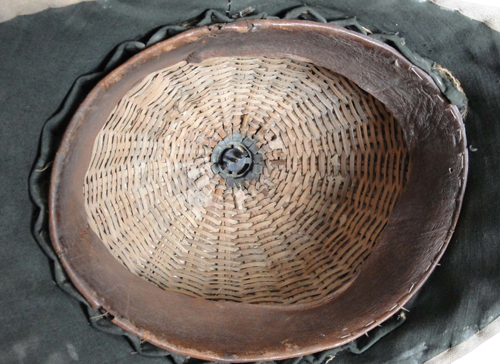
The interior of the ‘K’ pattern clearly showing the wicker construction. Some remnants of the sola-pith lining are visible and the pith-band, which replaced the puggaree, is filled with sola-pith. (Author’s collection)
As W.B. Rowbotham, Commander, R.N. says “For a few years before the Indian Mutiny some of the Irregular Cavalry regiments had been wearing these wicker helmets and had found them quite satisfactory. The white cover for the shako worn by British troops in India was a poor protection against the sun, and Sir Colin Campbell, the Commander-in-Chief, who was no stickler for the peace-time dress foibles of the Court-of-Directors of the Honourable East India Company, decided that something must be done to reduce the large number of cases of sun-stroke. The action he took is described in the following précis of the correspondence on the subject:-
‘Adjutant-General to President-in-Council, 4th June (1858). The Commander-in-Chief suggests that the shakos worn by European troops be discontinued and replaced by a light, helmet-shaped cap made of wicker and covered with cotton cloth, wound round with a thick turban. The advantage is that it protects the temples and side of the head, which no shako cover does. Some detachments have already worn these [author’s italics] and they can be easily procured in this country…He urges the approval of the Court-of-Directors and sanctions their use now…’” 1
That this correspondence was effective is substantiated by an order taken from the Regimental Order Books of the 61st Regiment of Foot, dated 24th June 1859, at Poona as follows:-
“The Regiment will parade for inspection of the Commander-in-Chief at ½ past 5 o’clock tomorrow afternoon, and will wear Tunics, Cloth Trousers and Wicker Helmets. The Officers Tunics and Forage Caps.” 2
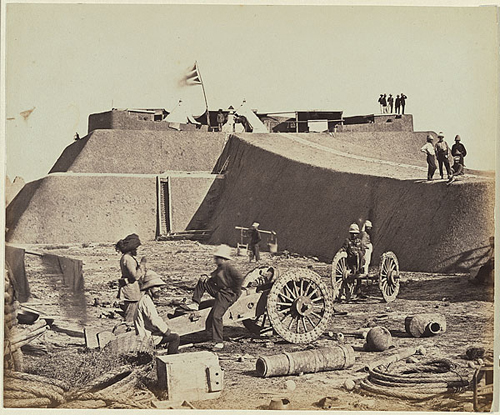
This famous photo, by Felice Beato, titled “Headquarter Staff Pehtang Fort 1st August, 1860” shows the styling difficulties encountered early with the use of wicker. The helmet in the left foreground shows the distinct slab-sided nature of these early examples.
Captain R. Steele states that “Although ‘Solar Topees’ were worn in the Sikh Wars [1845-1846, 1848-1849] by European officers on the Staff, and also by officers in the Mutiny, it is thought the following regulation (G.O.C.C. Bengal, 12th September, 1864) may be the first which actually prescribed their use:-
“In addition to the dress prescribed in Her Majesty’s Regulations, Officers of the Native Infantry Regiments are to provide themselves with Helmets (Wicker) of the Ellwood pattern, which are to be worn on all fatigues and ordinary duties. With a Turban of the colour of the head-dress worn by their men.” 3
It is interesting to note that this order is directed to officers of Native Infantry regiments only and then only for fatigues and other duties.
The wicker helmet was widely criticized as the following extracts attest. Firstly from Lieutenant Vivian Dering Majende writing in 1859: –
“There are the tailors too, who have got their hands as full as they will hold… and turning out sun-defying but exceedingly unbecoming wicker helmets.”
“Under any circumstances, the wicker helmet used by the men is by no means a becoming head-dress, giving an appearance to the wearer of being extinguished.” 4
The author can only speculate on what he meant by “extinguished.” And the following extract is taken from the Army Medical Department Report of 1869. 5
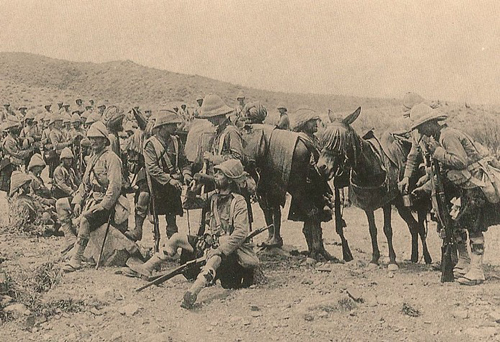
2nd Battalion, the Argyll & Sutherland Highlanders in India. Note the rather less than glamorous wicker helmets worn by some and the cork Colonial helmet worn by the officer.
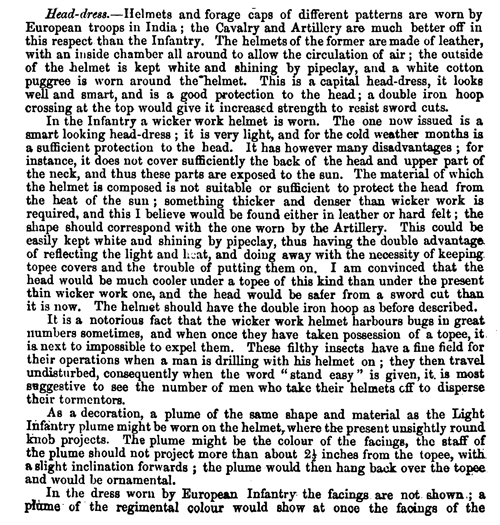
Another extract from the Army Medical Report 1869 this time by Assistant-Surgeon L. Corban, M.D., 21st Hussars.
However, not all commanders rounded on the helmet and as Lord Roberts said:-
“While at Allahabad, on the 13th January [1858] —quite the coolest time of the year—I had a slight sunstroke, which it took me a very long time to get over completely. The sensible custom introduced by Lord Clyde, of wearing helmets, was not always adhered to, and Sir Hugh Rose was rather fond of cocked hats. On this occasion I was wearing this—for India—most unsuitable head-dress, and, as ill-luck would have it, the Chief kept me out rather late, going over the ground where the present cantonment stands. I did not feel anything at the time, but an hour later I was suddenly seized with giddiness and sickness, and for a short time I could neither see nor hear. Plentiful douches of cold water brought me round, and I was well enough in the afternoon to go with the Chief to inspect the fort; but for months afterwards I never lost the pain in my head, and for many years I was very susceptible to the evil influence of the sun’s rays.” 6
Stuart Bates
1 Journal of the Army Historical Society Vol. XXVII, 1949, kindly supplied by Peter Winfield
2 Journal of the Army Historical Society Vol. XXXVII, 1959, kindly supplied by Peter Winfield
3 Journal of the Army Historical Society Vol. XVIII, 1939, kindly supplied by Peter Winfield
4 Majende, Lt. V.D., Up Among the Pandies, Routledge, Warne, and Routledge, London, 1859
5 Army Medical Department Report of 1869
6 Roberts, Frederick Sleigh, Forty-one Years in India: From Subaltern To Commander-in-Chief,1897

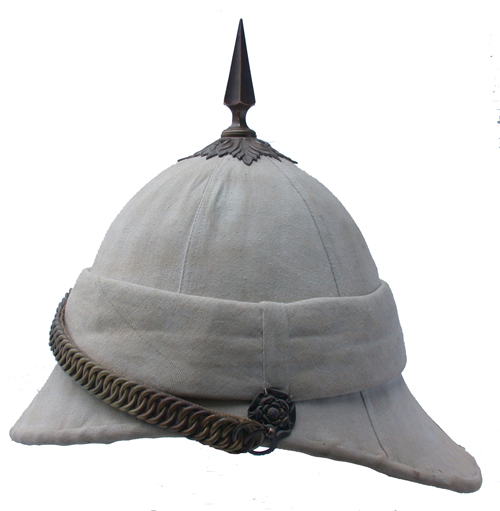
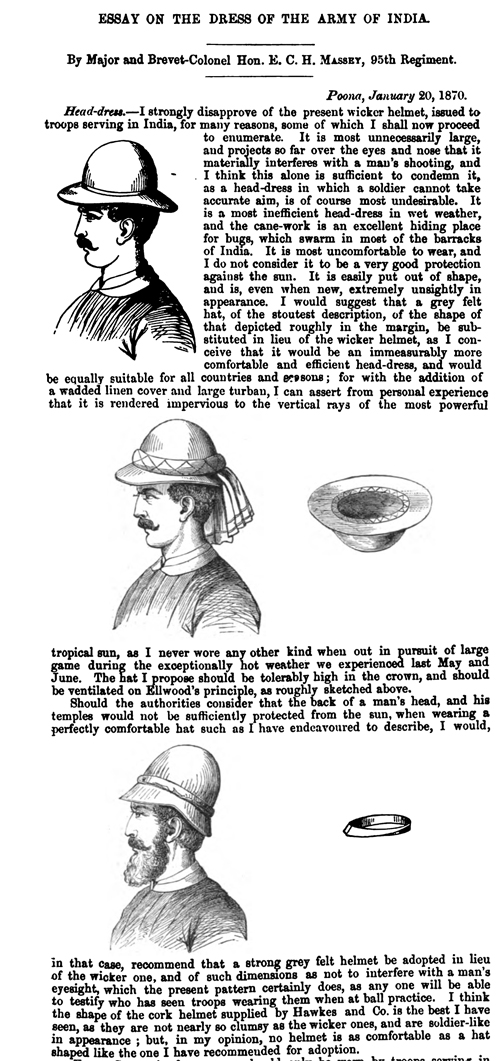
Very nice article. I especially like the photo of the 2nd A&SH showing the large neck curtain around the helmets of some of the ranks giving it a somewhat “un-soldierly” look. This is the same neck curtain worn by the 21st Lancers in the Sudan 1898. A carry over from their days in India when they were still Hussars.
Jim Holt
Stuart- unless I have missed the point entirely and you have not- I would like to suggest that Lieutenant Majende’s 1859 description of wearers of the wicker helmet having the appearance of being “extinguished” is a droll allusion to a conical candle snuffer being placed on top of a candle. Regards, JF
Dear Jack,
as I said I could only “speculate” on Majende’s description – which obviously I did not in the article. You could be quite correct in your assertion of a similarity to a candle-snuffer, but what lead you to this assumption?
Best regards,
Stuart
Belatedly responding to your question, Stuart, my assumption came from an instinctive comparison between the shape of the less attractive forms of the wicker sun helmet, as in the Beato photograph, and the image conjured by the writer’s use of the word ‘extinguished’- a word which is generally used with reference to fire and flames.
Jack,
on re-reading the extract you could very well be correct. It does, indeed, seem to fit.
Stuart